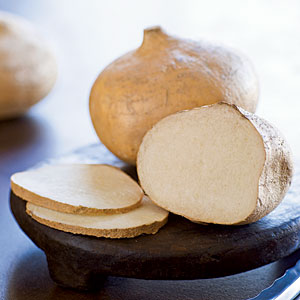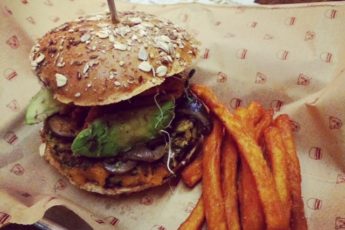Unlike a potato, the skin is not edible, and needs to be peeled off before you can eat it. Once you peel the skin, the white flesh is best served cubed or in long thin strands. Aside from the edible root, be careful that you do not to eat any other part of the plant because it can be very toxic. The seeds contain a toxin called rotenone, which is used to as an insecticide and pesticide. This is definitely not something you want to find yourself eating.
The Jicama is most commonly served raw, but can be boiled or fried and still retain its crisp texture. Think of it as a Mexican water chestnut. Sometimes I even use it in Asian stir-fries as a substitute.
So once you peel the skin, and cut this vegetable in pieces, what else can you do with it in raw form? I love to throw it in my vegetable salad along with avocado or mango to get that added juicy crunch contrasting the soft texture of my fruit.
Some of the other common uses of raw jicama include:
- Served raw as a snack dusted with salt and chili powder and squeezed with lemon or lime juice.
- As a crudité for your favourite dips or salsa.
- Added to fruit salad.
- Substituted for vegetables such as potatoes, cabbage, cucumber or carrots.
- Roasted in the oven and served along side your main dish, or you can leave it in longer and eat as a chip.
- Added into sushi or fresh salad rolls.
- Served in soups.
The unique thing about jicama is that although it is relatively high in carbohydrates, but mostly a dietary fiber called inulin. This type of carbohydrate has 0 calories, and is not metabolized by the body. By taking up room in our digestive tracks, but not being digested, it helps to make us feel full! Inulin is also responsible for promoting good bone health by improving calcium absorption and protecting against osteoporosis. It also works as a prebiotic and promotes good bacteria growth. The best part of this type of fiber is that while it is keeping you feeling full, it lacks the added calories that most carbohydrates have. Although, they do contain some sugar, so make sure not to over eat this starchy white vegetable.
When you are choosing your jicama at the grocery store, do not be afraid of how big they can get. Jicama roots can weigh as much as 50 pounds! However, the most nutritious and juicy ones will be the ones weighing only about 5 pounds. I find you can store them for about a week in the fridge once they are cut, allowing you to try out their different uses everyday.
So next time you find yourself bored of your usual salad or vegetable intake, try adding a jicama into the mix and reap the health benefits, as well as a new taste and texture combination.



